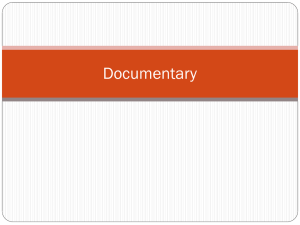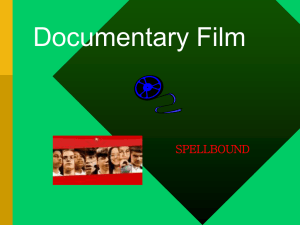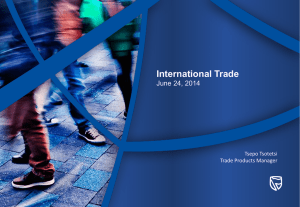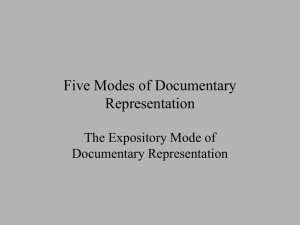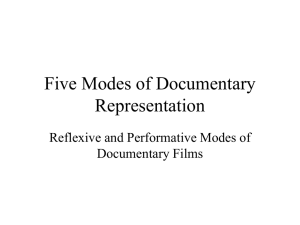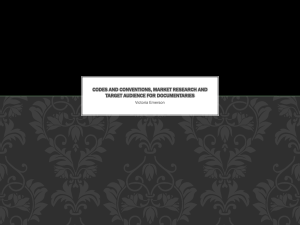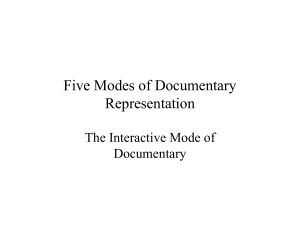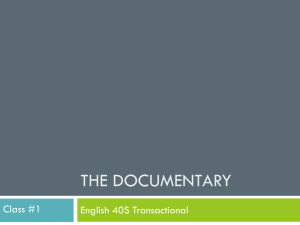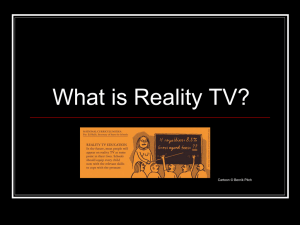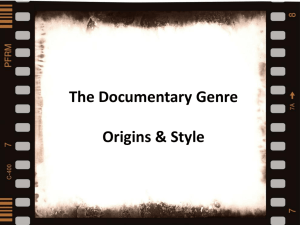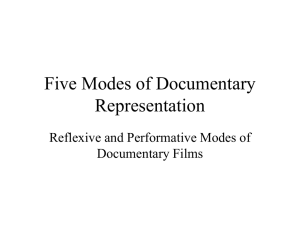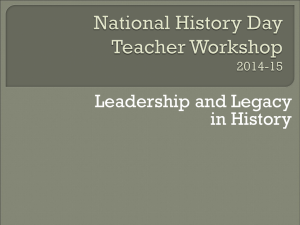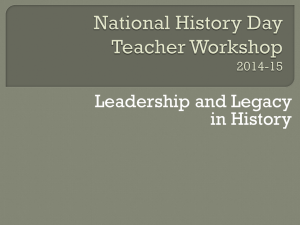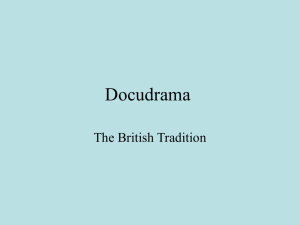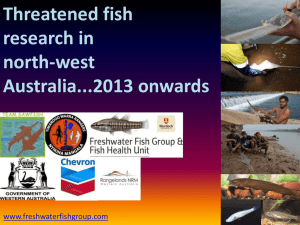Document
advertisement
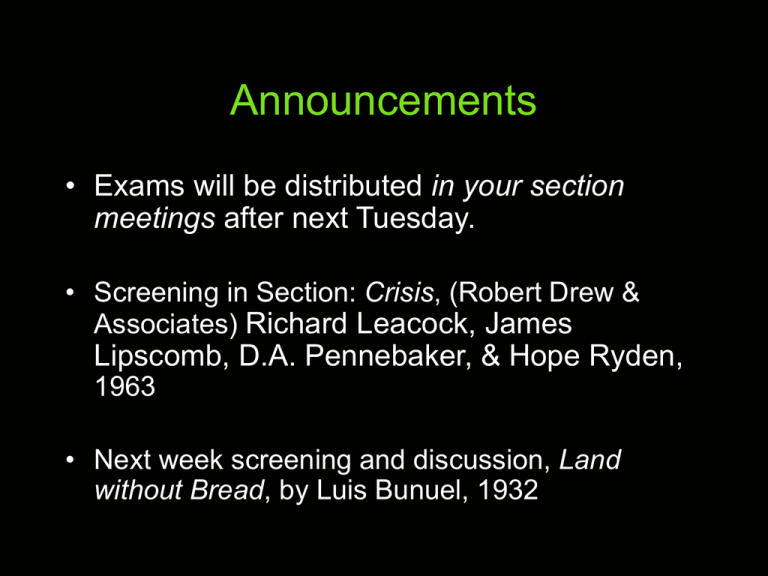
Announcements • Exams will be distributed in your section meetings after next Tuesday. • Screening in Section: Crisis, (Robert Drew & Associates) Richard Leacock, James Lipscomb, D.A. Pennebaker, & Hope Ryden, 1963 • Next week screening and discussion, Land without Bread, by Luis Bunuel, 1932 Paper Tiger TV Wed Feb 13, 7pm, Free Vis Arts Performance Space A presentation by an alternative Television collective that has been active since 1981. Documentary - Non-Fiction Film and Video Making Representing Reality Defining Documentary Non-fiction? Non-narrative? Instructive or educational? Truthful? Objective? Every media-object can be understood as a document. (The Great Train Robbery?) Documentary can be understood as a set of practices of media-making, distribution, and viewing/reception. The Internet Archive: http://archive.org Defining Documentary “Documentaries are the creative treatment of actuality” - John Grierson, Critic and Filmmaker “Documentaries are representations of reality” - Bill Nichols, Historian and Theorist “Documentaries are performed reality” - Stella Bruzzi, Historian and Theorist The Form of Documentary Images: Disparate image and sound sources (original footage/recordings, archival, dramatized, photographs, paper documents) Editing: Evidentiary Organization: Development of idea / argument The Form of Documentary 1. Offer a likeness or depiction that has relationship to the familiar…but see it anew 2. Stand for or represent the interests of others 3. Make a case for a particular view or interpretation Form in Documentary “Since there is nothing natural about the representation of reality in documentary, documentary filmmakers are acutely aware that all there choices shape the meanings they choose” Aufterheide The history of documentary is a history of media producers creatively struggling with how to represent or engage reality. Some key concerns that have driven decisions about formal conventions: Authenticity and honesty - to be true to the subject and avoid misleading viewers. Agency - to facilitate action on the part of the viewer, allow for the voice or desires of the subject, etc. Technical changes have shaped these conventions as well, such as availability of lightweight camera, introduction of TV and video, etc Four Tendencies of Documentary Documentary historian and theorist, Michael Renov: 1. To record, reveal or preserve 2. To persuade or promote 3. To analyze or interrogate 4. To express Out of what (public) contexts and for what reasons do these tendencies develop? What means do filmmakers use to achieve these ends? Emergence of Documentary Film emerged in the context of the late European colonialism and US expansion. Early documentary practice intersects with practices of ethnography and anthropology. At the same time it is seen as a tool in the service of modern national-building and war (propaganda). Envisioned as addressing the difficulty of social and political participation in a complex world. Conceived in contrast to entertainment cinema; and as an extension of popular press. “The importance of Documentaries is linked to a notion of the public as a social phenomenon”- Aufterheide Subject and Voice of Documentary What is being represented? And why? Who is being looked at? Who is looking? Who is speaking for whom? Who is speaking about whom? Who is being spoken to? Can the ‘subject’ speak about themselves? Voice of Documentary Who is “speaking” about or for whom is an important characteristic of documentaries: I (film/media-maker) speak about them to you. It (media) speaks about them to us. I or we speak about us to you. I facilitate them speaking to you/us/themselves. Styles or Modes of Documentary • • • • • • Expository Poetic Observational Reflexive Participatory Performative These six categories are suggested by Bill Nichols Nanook of the North, Robert Flaherty, 1922 Expository / observational / poetic? Use of narrative as a device - Flaherty argued that this was more true to his intentions of presenting a humanizing view of the Inuit. Anachronistic representation of Inuit Didn’t credit actors with their actual names Projecting foreign values such as nuclear family Inuit Broadcasting Corp: http://inuitbroadcasting.ca/ (A contemporary example of self-determined media) Man with a Movie Camera, Dziga Vertov, Soviet Union, 1928 Poetic / observational / reflexive? Argued that documentary was a more appropriate use of film to the modern world than narrative fiction. Kino-Eye: argued that the camera extended and transformed vision in ways that were superior to the human eye. At the same time he saw the role of editing (human agency) as central to making sense or a truthful representation out of the chaos of modern life. Expository Documentary Argumentative logic / rhetorical frame Verbal commentary; authoritative “voice of god” narration Single perspective, not acknowledging subjectivity Addresses the viewer directly Evidentiary editing - serves the argument primarily, crosses space and time Image/sound - images respond to sound Expository Documentary The Drifters, 1928, John Grierson. Great Britain. A film on herring fishermen. Influenced by Flaherty’s films; sought to apply the form to local/national issues. The River, Pare Lorentz, 1937. Produced for the Farm Works Administration to promote the Roosevelt’s New Deal and the TVA. Listen to Britain, Humphrey Jennings. 1942 Poetic or Impressionist mode • Lyrical • Photogenie - overwhelmed by sensation; defamiliarizing • Stylized / aestheticized: “historical world” broken up into fragments and aesthetically reconstituted. • Might blur fact and fiction • Sometimes uses strong musical elements in soundtrack • The subjective position of the film(maker) is more evident. Example: Rain, Joris Ivens, 1928 (Dutch) Observational Documentary • A highly visual approach: the shots tell the story • Extensive use of long takes and close-ups. • Usually lacks an overarching narrative--follows the unfolding of observed situation or event. • Attempts to record events spontaneously, with minimum of intervention. • Sound is mostly diegetic. Absence of narrator or voiceover. Dedicated to presentation of real-time events • Direct Cinema (the American counterpart Cinema Verité) was dedicated to a "fly on the wall" approach. Observational Documentary • This mode is often described as a critical response to the expository form. (Renouncing its moralist tone and rejecting its disembodied, authoritative "the voice of God" narration.) • Made possible by new technologies: lightweight, quiet, syncsound cameras (magnetic sound) enable field interviews, and allowed the story to be told through the action itself rather than dubbed narration. Observational Documentary Primary, Robert Drew, Richard Leacock, James Lipscomb, DA Pennebaker, & Hope Ryden, 1961. High School, Frederick Wiseman, 1968 An American Family, PBS, 1973 http://subcin.com/americanfamily.html Reflexive Documentary Apparatus revealed (filmmaker, crew and/or aspects of production process enter the frame or narrative) The text is about viewer / filmmaker relationship Reveals the perspective of the filmmaker - perhaps his or her own voice Confronts/readjusts our assumptions as viewers Can be reflexive from formal and political perspectives Examples: Reassemblage, Trinh T. Minh-ha, 1978 Land without Bread, Bunuel, 1932 Human Remains, Jay Rosenblatt, 1999 Thin Blue Line, Errol Morris, 1988 Bus 174, José Padilha, 2002 (Brazil) Land Without Bread, Luis Bunuel, 1932 • Parodying conventions of expository mode used in ethnographic film and travelogues • Reflexivity--aims to make viewers selfconscious of their and the filmmaker’s relationship to the subjects Thin Blue Line Errol Morris, 1988 • Film explores the evidence in murder of a Dallas police officer in 1976 was entered as evidence in a retrial that overturned the original conviction . • Heightens our awareness of the subjective nature of knowledge and memory • Interrogates POV • Employs self-consciously dramatic use of music and graphics Participatory (Interactive) Documentary • Attempts to confront the social and power dynamics that occur during filmmaking and structure a film's meaning. • Filmmaker and crew's relationships to the subject are more evident or embodied in film. They are participant-observers. • The filmmaker may participate, intervene in, or provoke the events or actions being filmed. • Sometimes the filmmaker attempts to shift aspects of control of the production into the subjects' hands. For example: an ethnographer who gives cameras to to his subjects or allows them to determine what shots should be included. Participatory Documentary Cinema Verite (and Direct Cinema to a lesser degree) Examples: • Chronicle of a Summer, Jean Rouch, 1960 (France) • Grey Gardens, Maysles Brothers, 1976 • George, Henry Cora and Grahame Weinbren, 1998 • Capturing the Friedmans, by Andrew Jarecki, 2003 • Navajo Talking Picture, Arlene Bowman, 1986 • When Billy Broke His Head, Billy Golfus & David E. Simpson, 1994 Performative (or Personal) Documentary • Expression of embodied knowledge • Attempts to convey understanding that can not simply be observed • Filmmaker is or has intimate relationship to subject • Meaning expressed poetically, through gesture, reenactment, etc Examples: • Tongues Untied, Marlon Riggs, 1989 • The Body Beautiful, Ngozi Onwarah, 1991 • History and Memory, Rea Tejira, 1991 Godmilow: Kill the Documentary As We Know It Documentaries are supposedly sober unauthored texts Wants documentary to shift - become poetry, speculative fiction, critique, self-conscious Fearful of the ideology they hide Her manifesto is inspired by the Dogme 95 manifesto/ vow of chastidy (Lars von Trier and Thomas Vinterberg) http://www.dogme95.dk/the_vow/vow.html Godmilow: Kill the Documentary As We Know It • Documentary form has great respect as a way of achieving truth • Claim the real - privileged position Godmilow: Kill the Documentary As We Know It • Knowing is feeling better about oneself as viewer - knowing is enlightenment • First world - looking at third world • Middle / upper class - looking at lower class Godmilow’s Manifesto 1. Don't produce "real" time and space: your audience is in a movie theatre, in comfortable chairs. 2. Don't produce the surface of things: have a real subject and a real analysis -- or at least an intelligent proposition – that is larger than the subject of the film. If you forget to think about this before starting to shoot, find it in the editing room, and then put it in the film, somehow. Godmilow’s Manifesto 3. Don’t produce freak shows of the oppressed, the different, the criminal, the primitive. Please don't use your compassion as an excuse for social pornography. Leave the poor freaks alone. 4. Don’t produce awe for the rich, the famous, the talented, the highly successful: they are always everywhere and we feel bad enough about ourselves already. The chance to envy, or hate them, in the cinema doesn't help anybody. Godmilow’s Manifesto 5. Don’t make films that celebrate "the old ways" and mourn their loss. Haven’t you yourself enjoyed change? How are the "old ways" people different from you? 6. Keep an eye on your own middle-class bias, and on your audience's: don’t make a film that feeds it. Remember that you are producing human consciousness in people who are very susceptible to suggestion... and alone in the dark. Godmilow’s Manifesto 7. Don't address an audience of "rational animals": we have not yet evolved beyond the primitive urges of hatred, violence, and exploitation of the poor and the weak. 8. Try not to exploit your social actors: just being seen in your film is not enough compensation for the use of their bodies, voices and experience. Godmilow’s Manifesto 9. Whatever you do, don't make "history". If you can't help yourself, try to remember that you’re just telling a story -- and at the very least, find a way to acknowledge your authorship. 10. Watch that music: what's it doing? who is it conning? 11. Leave your parents out of this. Access: Video Technology and Documentary Activism • Introduction of real-time playback. • Video became available in the age of street activism. • In the early period (late 1960s through the 1970s) there was little distinction between video art and activist video as both were involved in street documentary. • Video was seen as alternative to broadcast TV. • It had an immediacy not found in broadcast TV. • It is much more interactive and personal than the film movements it draws upon. Access: Video Technology and Documentary Activism Early West Coast Video Collectives Four More Years, 1972, TVTV (True Value Television) Media Burn, and The Eternal Frame 1975, Ant Farm Reality TV • Appropriates the formal styles of observational and interactive modes. (direct cinema and cinema verité) • Truth is associated with formal conventions from low budget and home video technology. For example: raw footage or jerky camera work are used to suggest fact or reality. • Re-enactment is common. • Unlike direct cinema or cinema verite: the reality of reality TV is associated with the exceptional, the extreme, or the crisis. • The authority of the film or program often relies on experts or insiders associated with government or law enforcement.

